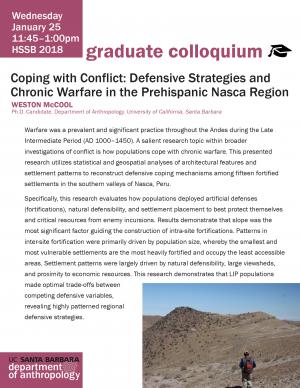Event Date:
Wednesday, January 25, 2017 - 11:45am to 1:00pm
Event Location:
- HSSB 2018
Coping with Conflict: Defensive Strategies and Chronic Warfare in the Prehispanic Nasca Region
WESTON McCOOL, Ph.D. Candidate, Department of Anthropology, University of California, Santa Barbara
Warfare was a prevalent and significant practice throughout the Andes during the Late Intermediate Period (AD 1000–1450). A salient research topic within broader investigations of conflict is how populations cope with chronic warfare. This presented research utilizes statistical and geospatial analyses of architectural features and settlement patterns to reconstruct defensive coping mechanisms among fifteen fortified settlements in the southern valleys of Nasca, Peru.
Specifically, this research evaluates how populations deployed artificial defenses (fortifications), natural defensibility, and settlement placement to best protect themselves and critical resources from enemy incursions. Results demonstrate that slope was the most significant factor guiding the construction of intra-site fortifications. Patterns in inter-site fortification were primarily driven by population size, whereby the smallest and most vulnerable settlements are the most heavily fortified and occupy the least accessible areas. Settlement patterns were largely driven by natural defensibility, large viewsheds, and proximity to economic resources. This research demonstrates that LIP populations made optimal trade-offs between competing defensive variables, revealing highly patterned regional defensive strategies.
January 20, 2017 - 4:27pm




